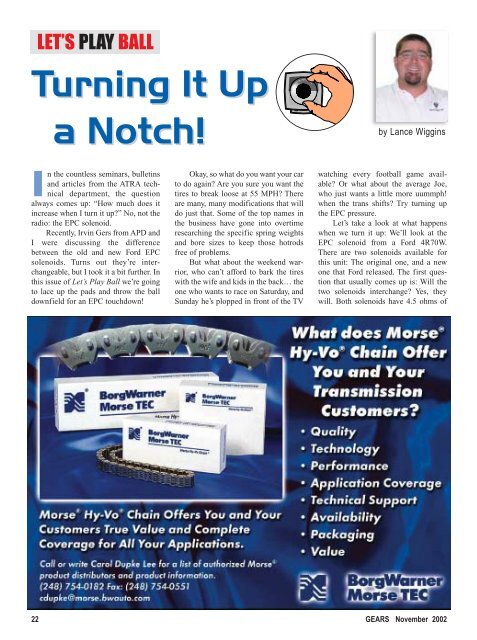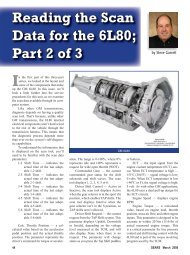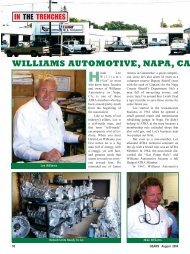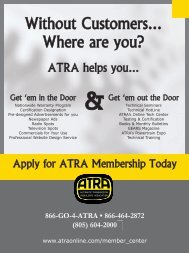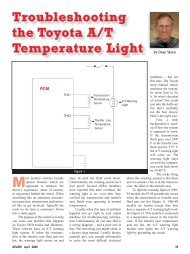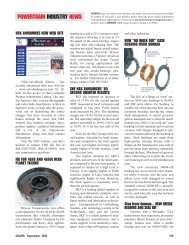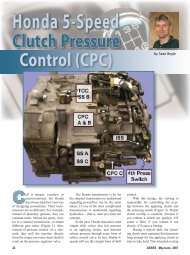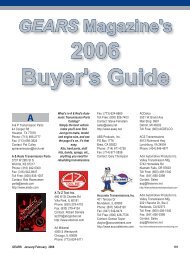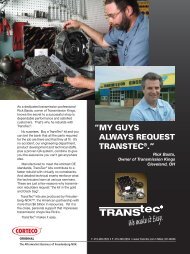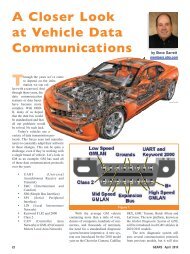Turning It Up a Notch! - ATRA
Turning It Up a Notch! - ATRA
Turning It Up a Notch! - ATRA
You also want an ePaper? Increase the reach of your titles
YUMPU automatically turns print PDFs into web optimized ePapers that Google loves.
LET’S PLAY BALL<br />
<strong>Turning</strong> <strong>It</strong> <strong>Up</strong><br />
a <strong>Notch</strong>!<br />
In the countless seminars, bulletins<br />
and articles from the <strong>ATRA</strong> technical<br />
department, the question<br />
always comes up: “How much does it<br />
increase when I turn it up?” No, not the<br />
radio: the EPC solenoid.<br />
Recently, Irvin Gers from APD and<br />
I were discussing the difference<br />
between the old and new Ford EPC<br />
solenoids. Turns out they’re interchangeable,<br />
but I took it a bit further. In<br />
this issue of Let’s Play Ball we’re going<br />
to lace up the pads and throw the ball<br />
downfield for an EPC touchdown!<br />
22 GEARS November 2002<br />
D A Y & N I G H T<br />
60<br />
HOT OFF COOL<br />
Okay, so what do you want your car<br />
to do again? Are you sure you want the<br />
tires to break loose at 55 MPH? There<br />
are many, many modifications that will<br />
do just that. Some of the top names in<br />
the business have gone into overtime<br />
researching the specific spring weights<br />
and bore sizes to keep those hotrods<br />
free of problems.<br />
But what about the weekend warrior,<br />
who can’t afford to bark the tires<br />
with the wife and kids in the back… the<br />
one who wants to race on Saturday, and<br />
Sunday he’s plopped in front of the TV<br />
70<br />
80<br />
by Lance Wiggins<br />
watching every football game available?<br />
Or what about the average Joe,<br />
who just wants a little more uummph!<br />
when the trans shifts? Try turning up<br />
the EPC pressure.<br />
Let’s take a look at what happens<br />
when we turn it up: We’ll look at the<br />
EPC solenoid from a Ford 4R70W.<br />
There are two solenoids available for<br />
this unit: The original one, and a new<br />
one that Ford released. The first question<br />
that usually comes up is: Will the<br />
two solenoids interchange? Yes, they<br />
will. Both solenoids have 4.5 ohms of
We performed these tests<br />
on a 2000 Ford F150 and<br />
a 1999 Lincoln Navigator;<br />
both vehicles with<br />
less then 50k miles.<br />
resistance at room temperature, and the pressure ranges are<br />
very similar, as you’ll see by the results. We performed these<br />
tests on a 2000 Ford F150 and a 1999 Lincoln Navigator;<br />
both vehicles with less then 50k miles.<br />
The first graph (figure 1) indicates an early (F8 part<br />
number) solenoid operating at the normal factory setting.<br />
Notice the pressures on the right and the current flow in<br />
amps at the top of the chart; these are going to be our indicators<br />
for comparison.<br />
The EPC pressure and amperage are inversely proportional;<br />
that is, the higher the current flow, the lower the pressure,<br />
and the lower the current flow, the higher the pressure.<br />
Because the solenoid is normally open, energizing the solenoid<br />
closes it. As the current varies, the pressure adjusts<br />
accordingly.<br />
When we turned the solenoid screw a quarter turn in<br />
(clockwise), we noticed a slight but effective change. Look<br />
at both of the graphs closely (figure 2). Both idle and<br />
SHARE THE ROYALTIES<br />
We are Lee Myles Area Developers…<br />
Former Independents who said…<br />
“Join a franchise…never, not me”<br />
After opening our minds<br />
to the possibilities, we<br />
were able to take our<br />
years of experience<br />
operating successful<br />
transmission centers…<br />
And turn them into money making opportunities<br />
by helping others to learn a business system<br />
designed to achieve their individual goals.<br />
We now earn up to 50% of the royalties on the<br />
centers we support…and we are building a network<br />
and a bright future for them and ourselves.<br />
Area Development Rights are AWARDED…NOT SOLD<br />
To qualifying applicants in select markets. There<br />
are several still available, but they are going fast…<br />
To learn more and for your free information package<br />
Call Mark Savel at 1-800-251-8250<br />
…Is<br />
Muscle MT-10<br />
“The Original”<br />
Metal Treatment<br />
Figure 1<br />
Figure 2<br />
The Key to<br />
Reducing<br />
Costly Come<br />
Backs…<br />
Muscle Products Corp.<br />
"The Strength in Lubrication TM "<br />
112 Fennell Drive<br />
Butler, PA 16002<br />
Phone: (800) 227-7049 or<br />
(724) 283-0567<br />
Fax: (724) 283-8310<br />
http://www.mpc-home.com<br />
GEARS November 2002 23
<strong>Turning</strong> <strong>It</strong> <strong>Up</strong> a <strong>Notch</strong>!<br />
EPC SOLENOID<br />
1/2 Turn<br />
part-throttle pressures increase slightly<br />
from the factory setting. This is just<br />
enough to make those shifts feel right<br />
on the money, on a unit with normal<br />
wear.<br />
Next, we cranked the screw in<br />
another quarter turn, for a total of a half<br />
turn clockwise. This is where your neck<br />
starts to snap back, and the pressure<br />
climbs to where it’ll bark the tires if you<br />
have the horses to push it. As the graph<br />
shows (figure 3), the pressure is significantly<br />
higher and increases much<br />
faster than the two previous graphs.<br />
Comparing the pressures through<br />
the EPC is good, but comparing mainline<br />
response will really get your heart<br />
pounding. With the adjustment set at<br />
factory specs, mainline pressures were<br />
between 60 and 70 PSI at idle, with<br />
EPC pressure at minimum 0.0 PSI. As<br />
throttle and torque increased, the pressure<br />
rose to 170 PSI, and finally to<br />
about 200 PSI at WOT.<br />
When we turned the pressure up a<br />
TURN IT UP!<br />
1/4 Turn<br />
Figure 3<br />
quarter turn, idle pressure was at 90<br />
PSI, with a WOT at 230 PSI. At half a<br />
turn in, idle pressure was at 105 PSI,<br />
and WOT at 240 PSI. As exciting as the<br />
pressure change was, what’s really<br />
exciting was how much faster the pressures<br />
increased, and the response of the<br />
clutch application. This is the touchdown<br />
throw, and the celebration in the<br />
endzone.<br />
So far we’ve been looking at only<br />
the early solenoid; the late model didn’t<br />
perform as well as the earlier solenoid.<br />
With a much faster response time and<br />
higher pressures to boot, the earlier<br />
EPC solenoid looks to be the solenoid<br />
of choice. As for the comparison (figures<br />
4 and 5) the black line indicates the<br />
response at the factory setting; red is<br />
the response with the screw turned in a<br />
quarter turn; blue is the response at a<br />
half-turn in.<br />
The post-game stats show that<br />
turning up the EPC solenoid is okay,<br />
provided the rest of the unit is tight. But<br />
Figure 4<br />
Figure 5<br />
The black line indicates the<br />
response at the factory setting;<br />
red is the response<br />
with the screw turned in a<br />
quarter turn; blue is the<br />
response at a half-turn in.<br />
don’t get careless: Any excess wear in<br />
the valve bores or clutches are a sure<br />
way to fumble the ball. Not only will<br />
these conditions cost you time and<br />
money, but they may also cost you your<br />
customer. And, in general, you’ll want<br />
to stay with a quarter turn for your regular<br />
customers; half a turn for the customer<br />
who wants to chirp the tires.<br />
Anything more than that is just asking<br />
for a penalty on the play.<br />
So the next time you get a 4R70W<br />
in the shop, don’t be afraid to turn it up<br />
a notch. <strong>It</strong>’ll make those shifts a little<br />
bit better, and make your customers<br />
really stand up and cheer! And that’s the<br />
Game...<br />
24 GEARS November 2002
Introducing a whole new way<br />
to order transmission parts.<br />
Transtar’s StarSystem represents more than just the<br />
convenience of a single-source transmission parts supplier. <strong>It</strong><br />
means OEM quality across the board in torque converters,<br />
electrical, hard parts and rebuilder kits. <strong>It</strong> means a state-ofthe-art<br />
inventory management and sales forecasting system,<br />
and people in more than 20 locations across the country,<br />
trained to handle every facet of the business. <strong>It</strong> means the<br />
kind of reliability that established Transtar as “The Premier<br />
Transmission Parts Company in the World!” The only company<br />
in the universe that could offer you the StarSystem .<br />
Five Points of the StarSystem <br />
• Selection. A complete system of kits, parts, and service<br />
items to repair more than 100 different transmissions.<br />
• Consistency. Transtar’s proven track record of more<br />
than 25 years in business offers you consistency and<br />
reliability in our unparalleled combination of service,<br />
inventory, warranty, and delivery.<br />
• OEM Quality. Transtar delivers the world’s largest and<br />
most comprehensive line of OEM-quality automotive<br />
transmission parts. Buying transmission parts from Transtar<br />
is like taking out an insurance policy for quality!<br />
• Customer Service. More than 120 knowledgeable sales<br />
and sales support people are committed to handle ordering,<br />
servicing, and problem solving. Trained professionals with<br />
expert knowledge of the industry and the parts you need to<br />
get your job done right.<br />
• Delivery. The new Star Tracking System follows your order<br />
from the moment we receive it at one of our distribution<br />
facilities, to the moment you receive it. No lost orders. No<br />
excuses. Virtually every order is shipped complete the same<br />
day at a service level that consistently exceeds 95%.<br />
Visit the StarSystem — <strong>It</strong>’s out of this world!<br />
Call 1-800-359-3339 or visit us on the web at<br />
www.transtarindustries.com.<br />
Our Universe Is Transmissions


